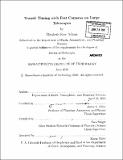Transit timing with fast cameras on large telescopes
Author(s)
Adams, Elisabeth Rose
DownloadFull printable version (17.00Mb)
Other Contributors
Massachusetts Institute of Technology. Dept. of Earth, Atmospheric, and Planetary Sciences.
Advisor
James L. Elliot and Sara Seager.
Terms of use
Metadata
Show full item recordAbstract
Timing and system parameters were measured for seven transiting exoplanets: OGLETR- 56b (11 transits), OGLE-TR-132b (7), OGLE-TR-111b (6), OGLE-TR-113b (6), CoRoT-2b (3), OGLE-TR-10b (3), and XO-2b (2). Ground-based observations of 38 transits were made using three new frame-transfer instruments: POETS and MagICe2v on the 6.5m Magellan telescopes, and MORIS on the 3m IRTF. For each planet, all transit light curves including available literature data were jointly fit using a Monte Carlo Markov Chain method, providing accurate new values for the planetary radius and other parameters. Transit ephemerides have been updated and transit midtimes have been investigated for potential transit timing variations (TTVs) caused by other planets or moons. Our transit midtime analysis contradicts a claimed TTV for OGLE-TR-111b (Diaz et al., 2008), finding no evidence in data from 2005-2009. The radius, 1.019 + 0.026 Rj, is intermediate to previous values (Winn et al., 2007; Diaz et al., 2008). We confirm the radius of OGLE-TR-56b, which previously had only one light curve (Pont et al., 2007), as 1.332 ± 0.063 Rj, but find a longer duration by 15 minutes, while the orbital period, 1.2119094 ± 0.0000024, is unchanged. Times for OGLE-TR-10b are consistent with the ephemeris of Holman et al. (2007), though two literature transits show large deviations (586 ± 86 s; Pont et al., 2007) and (-612 ± 26 s; Bentley et al., 2009). Times for four planets (OGLE-TR-113b, OGLE-TR-132b, CoRoT-2b, and XO-2b), with midtime errors as small as 9 s, agree with published ephemerides and show no signs of TTVs. The orbital period of OGLE-TR-113b derived from new data from 2007-2009, however, is shorter by 0.24 ± 0.12 s compared to the period calculated for literature data from 2002 and 2005. If confirmed, this would be the first detection of a change in the orbital period of an exoplanet, which could be caused by orbital decay as the planet falls onto its star.
Description
Thesis (Ph. D.)--Massachusetts Institute of Technology, Dept. of Earth, Atmospheric, and Planetary Sciences, 2010. Cataloged from PDF version of thesis. Includes bibliographical references (p. 171-178).
Date issued
2010Department
Massachusetts Institute of Technology. Department of Earth, Atmospheric, and Planetary SciencesPublisher
Massachusetts Institute of Technology
Keywords
Earth, Atmospheric, and Planetary Sciences.